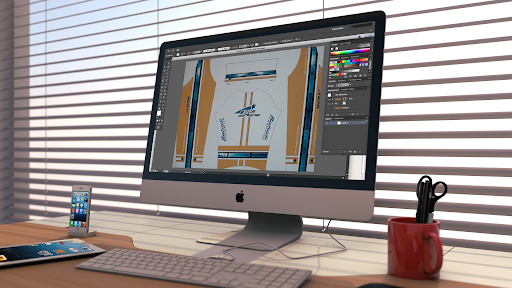
Designing sublimation sportswear involves a blend of creativity, technical knowledge, and an understanding of the sublimation printing process. This guide will walk you through the steps to create effective and appealing sublimation sportswear designs.
Step 1: Understanding Sublimation Printing
Before starting the design process, it’s crucial to understand how sublimation printing works. Unlike other printing methods, sublimation printing involves transferring dyes directly into the fabric using heat, resulting in vibrant, durable, and detailed designs. Keep in mind that sublimation works best on polyester fabrics and that the design’s colors can be influenced by the fabric color.
Step 2: Gather Tools and Resources
Software: Use graphic design software like Adobe Illustrator, Photoshop, or CorelDRAW. These programs offer the necessary tools for creating detailed and high-resolution designs.
Templates: Obtain sublimation templates for the specific sportswear you are designing (e.g., jerseys, shorts, leggings). These templates ensure your design will fit correctly on the garment.
Step 3: Conceptualize Your Design
Research and Inspiration: Look for inspiration in current sportswear trends, team colors, logos, and branding elements. Consider the purpose of the sportswear (e.g., team uniforms, fitness apparel) to guide your design choices.
Sketch Your Ideas: Start with rough sketches of your design concepts. Focus on the overall layout, including where logos, text, and patterns will be placed.
Step 4: Create the Design
Use Vectors: Create your designs in vector format. Vector graphics are scalable without loss of quality, which is essential for printing on various sizes of sportswear.
Color Selection: Use the CMYK color model for accurate color reproduction in printing. Be mindful of how colors will appear on the chosen fabric.
Design Elements:
- Patterns and Graphics: Incorporate patterns, gradients, and detailed graphics. Sublimation printing excels at reproducing complex designs.
- Logos and Text: Ensure logos and text are clear and appropriately sized. Use high-resolution files for logos to prevent pixelation.
- Layer Management: Keep your design organized by using layers. This makes it easier to adjust specific elements without affecting the entire design.
Step 5: Mock-Up and Visualization
Place Design on Templates: Overlay your design onto the sublimation templates to visualize how it will look on the actual garment. Adjust the design as necessary to ensure proper alignment and coverage.
3D Mock-Ups: Use software or online tools that offer 3D mock-up capabilities. This helps visualize the final product from different angles and makes it easier to spot any potential issues.
Step 6: Prepare for Printing
Resolution and Quality: Ensure your design is high resolution (at least 300 DPI) to prevent any quality loss during printing.
File Format: Save your design in the appropriate file format, typically a high-resolution PDF, EPS, or AI file. Check with your printer for their preferred format.
Color Proofing: Perform color proofing to ensure the colors in your design will match the final printed product. This may involve printing a small test sample.
Step 7: Communicate with Your Printer
Specifications: Provide your printer with detailed specifications, including fabric type, color codes, and placement instructions for each design element.
Sample Prints: Request sample prints to verify the quality and accuracy of your design before proceeding with full-scale production.
Tips for Effective Sublimation Sportswear Design
- Keep Functionality in Mind: Ensure that the design does not compromise the functionality of the sportswear. Avoid placing critical design elements over seams or areas that experience high wear.
- Brand Consistency: Maintain brand consistency by using the correct logos, fonts, and colors. This is especially important for team sportswear and branded fitness apparel.
- Innovative Designs: Don’t be afraid to experiment with bold and innovative designs. Sublimation printing allows for unique patterns and color combinations that stand out.
Conclusion
Designing sublimation sportswear involves a detailed and methodical approach, combining creative design with technical precision. By understanding the sublimation process and following these steps, you can create vibrant, durable, and functional sportswear that meets the needs of athletes and sports enthusiasts alike.
有限公司_画板-1.png)